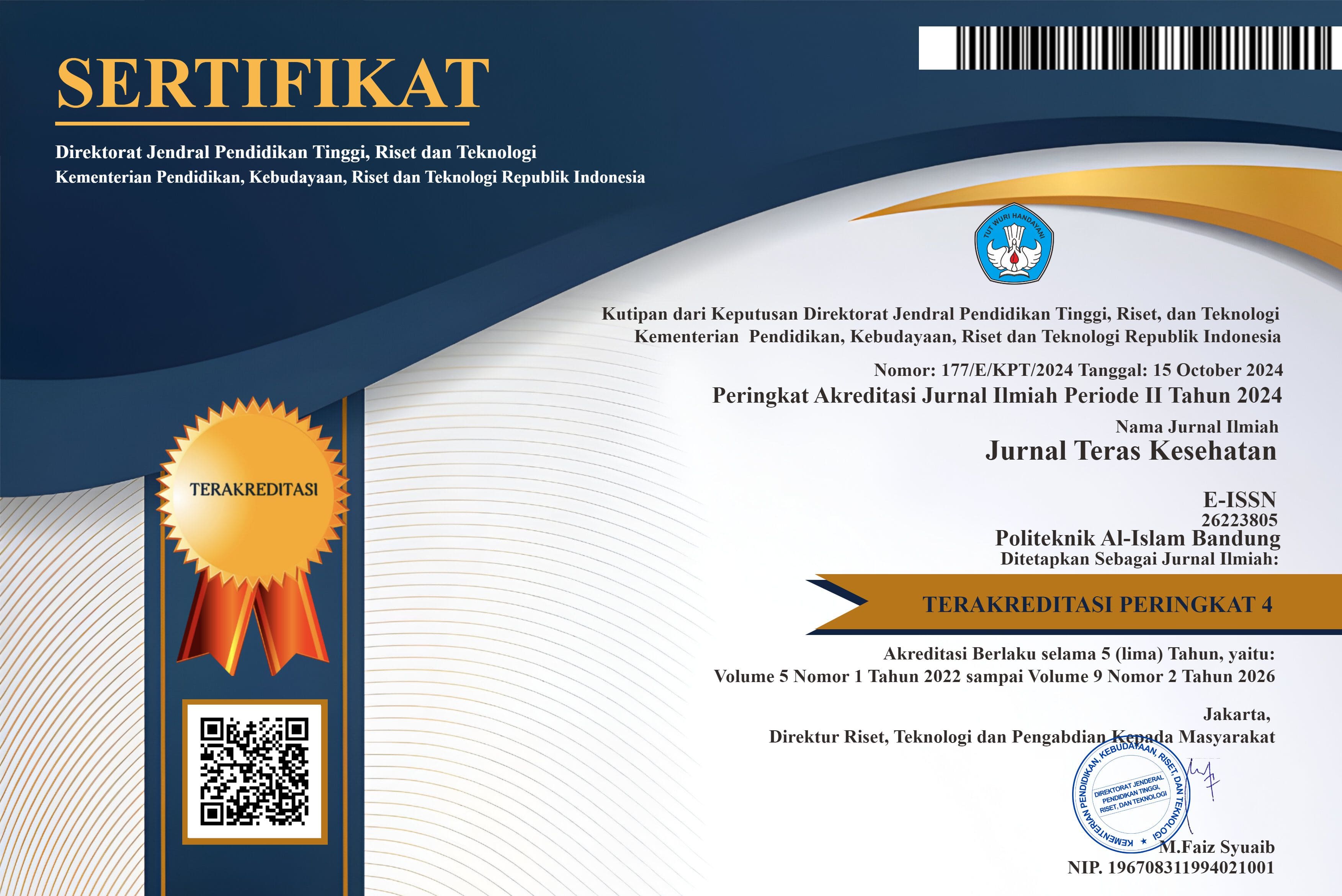PENERAPAN METODE MOTO-KINESTHETIC DALAM MENINGKATKAN KEMAMPUAN ARTIKULASI KONSONAN APICO-ALVEOLAR /-N/ PADA ANAK DENGAN GANGGUAN ARTIKULASI FUNGSIONAL
THE APPLICATION OF THE MOTO-KINESTHETIC METHOD IN IMPROVING ARTICULATION OF APICOALVEOLAR /-N/ IN A CHILD WITH FUNCTIONAL ARTICULATION DISORDER
DOI:
https://doi.org/10.38215/jtkes.v8i2.245Keywords:
consonant /-n/, functional articulation disorder, moto-kinesthetic method, speech therapyAbstract
Functional articulation disorder refers to difficulty in pronouncing speech sounds without any organic abnormalities in the structure or function of the speech organs. This study aims to evaluate the application and effectiveness of the moto-kinesthetic method in improving the articulation of the apicoalveolar consonant /n/ in a 5-year-old child with functional articulation disorder. The research method was a case study with a purposive sampling technique. Data were collected through interviews with the patient’s family, direct observation, as well as pre-test and post-test assessments to determine diagnosis, prognosis, and appropriate intervention strategies. The intervention consisted of ten therapy sessions using the moto-kinesthetic approach, which focuses on physical manipulation of the speech organs to support accurate articulation. Results showed an improvement in the child's articulation ability from a score of 0 to 4, representing a therapy success rate of 80%. These findings indicate that the moto-kinesthetic method is effective for treating articulation disorders, particularly in the pronunciation of the /-n/ sound, and may serve as a viable intervention strategy in clinical speech therapy practice.
Downloads
References
ASHA. (2018). Speech Sound Disordes-Articulation and Phonology. Retrieved 2024, from American Speech Language Hearing Association: https://www.asha.org/practice-portal/clinical-topics/articulation-and-phonology
Ekasari, T., & Dimalouw, A. N. (2022). Penerapan Metode Integral Stimulation Terhadap Pasien Dislalia. Jurnal Teras Kesehatan, 2(5), 32. doi:https://doi.org/10.38215/jtkes.v5i1.97
Guisti, M. A. (2002). The efficacy of oral motor therapy for children with mild articulation disorders [Southern Connecticut State University ProQuest Dissertations & Theses]. Southern Connecticut State University .
Murdani, C. K. S. (2025). Penerapan Metode Motor-Kinestetik untuk Mengatasi Gangguan Bicara Fungsional Penyanyi Seriosa. INVENSI: Jurnal Penciptaan Dan Pengkajian Seni, 10(1), 141–153.
Mansur, A. R. (2019). Tumbuh Kembang Anak Usia Prasekolah. Padang: Andalas University Press.
Nofadina, H., Hidayati, N. O., & Adistie, F. (2021). Hubungan Screen Time Penggunaan Smartphone dengan Perkembangan Sosial Anak Usia Prasekolah. Jurnal Mutiara Ners, 4(2), 89. doi: https://doi.org/10.51544/jmn.v4i2.1654
Piaget, J., & Inhelder, B. (2000). The psychology of the child. New York, NY: Basic Books.
Pranindyo, K. (2000). Metode-Metode Terapi Bidang Artikulasi. Jakarta Pusat: Klinik Bina Wicara "Vacana Mandiri"-YBW.
PMK. (2014). Peraturan Menteri Kesehatan Republik Indonesia Nomor 81 Tahun 2014 Tentang Standar Pelayanan Terapi Wicara, 9.
Riper, C. V., & Erickson, R. L. (1996). Speech Correction An Introduction to Speech Pathology and Audiology. Boston: Allyn & Bacon.
Sardjono. (2014). Terapi Wicara. Jakarta: Departemen Pendidikan Nasional.
Satrianingrum, A. P., & Andriyanti, E. (2020). Resiko Pengasuhan Permisif Orangtua dan Nenek Pada Pencapaian Bahasa Anak. Jurnal Ilmu Keluarga & Konsumen, 13(3), 240. doi:http://dx.doi.org/10.24156/jikk.2020.13.3.239
Suhartini, B. (2005). Deteksi Dini Keterlambatan Perkembangan Motorik Kasar Pada Anak (Vol. 1). Yogyakarta. doi: http://doi.org/10.21831/medikora.v1i2.4770
Sunanik. (2013). Pelaksanaan Terapi Wicara dan Terapi Sensori Integrasi pada Anak Terlambat Bicara. Jurnal Pendidikan Islam, 7(1), 30.
Wang, J. H., Xu, Q., Wang, X. Y., Wang, W. P., Li, N., Jin, C. H., Zhang, L. L., Wang, X., Li, X. M., Shi, X. M., & Wang, L. (2020). [Analysis of functional speech sound disorder and related erroneous consonants in children]. Zhonghua Er Ke Za Zhi = Chinese Journal of Pediatrics, 58(12), 995–1000. https://doi.org/10.3760/cma.j.cn112140-20200624-00662
World Health Organization. (2018). International Classification of Diseases for Mortality and Morbidity Statistics. Https://Icd.Who.Int/.
Young, E. H., & Hawk, S. S. (1955). Moto-kinesthetic speech training. Stanford, CA: Stanford University Press.
Yusuf, A., & Sari, M. I. (2019). Penatalaksanaan Kehamilan dengan Tuberkulosis Paru. Journal of Agromedicine, 625. Retrieved from http://repository.lppm.unila.ac.id/id/eprint/12572

Downloads
Published
Issue
Section
License
Copyright (c) 2025 Jurnal Teras Kesehatan

This work is licensed under a Creative Commons Attribution-ShareAlike 4.0 International License.
Authors who publish articles in Jurnal Teras Kesehatan agree to the following terms:
- Authors retain copyright of the article and grant the journal right of first publication with the work simultaneously licensed under a CC-BY-SA or The Creative Commons Attribution–ShareAlike License.
- Authors are able to enter into separate, additional contractual arrangements for the non-exclusive distribution of the journal's published version of the work (e.g., post it to an institutional repository or publish it in a book), with an acknowledgment of its initial publication in this journal.
Authors are permitted and encouraged to post their work online (e.g., in institutional repositories or on their website) prior to and during the submission process, as it can lead to productive exchanges, as well as earlier and greater citation of published work (See The Effect of Open Access)








